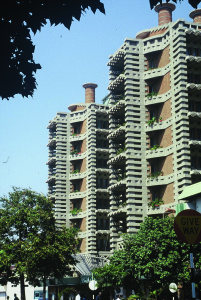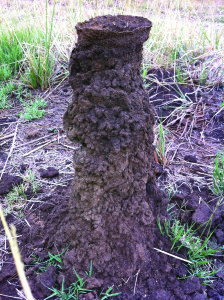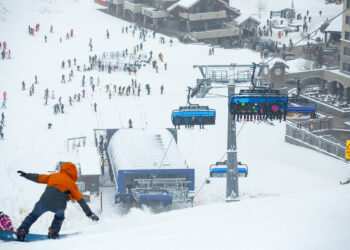The link between biology and business
By Andrew Graham
When the global architecture firm HOK turned to nature for design inspiration, Biomimicry 3.8’s team of world-class architects and engineers went to work.
This Missoula-based company combines for-profit consulting with not-for-profit advocacy to advance the field of biomimicry; solving human problems by replicating the adaptive mechanisms found in nature. The “3.8” in the company’s name refers to the 3.8 billion years life is believed to have existed on Earth, forming myriad solutions at evolution’s design table.
“Companies are trying to mimic what nature does because it’s efficient, saves them energy, it’s good for PR, and because it’s cheaper,” says Robyn Klein, a biologist and research analyst for 3.8.
Examples of biomimicry abound, and were present in industry before the term itself. Klein points out that one of the earliest industrial applications of biomimicry is Velcro, which was invented by a Swiss engineer who noticed the way plant burrs stuck to his dog.
 A more modern example is found in an office complex in tropical Zimbabwe. The building’s self-cooling
A more modern example is found in an office complex in tropical Zimbabwe. The building’s self-cooling system is inspired by termites that design their mounds to maintain a constant temperature, even as outside air temps swing from hot desert days to cold nights. The result is a building that uses 90 percent less energy than those of similar size, according to 3.8’s website.
system is inspired by termites that design their mounds to maintain a constant temperature, even as outside air temps swing from hot desert days to cold nights. The result is a building that uses 90 percent less energy than those of similar size, according to 3.8’s website.
When a new client comes to Biomimicry 3.8 – and past business includes Coca-Cola, Boeing, Dupont, Nike and Shell, to name a few – the first step is to establish a challenge for a researcher like Klein to focus on.
With HOK, the challenge was to look at a biome, or particular ecosystem type, for lessons that could be applied to architecture. The Biomimicry 3.8 team chose to study temperate broadleaf forests, found all over the world.
Studying the designs and systems a forest uses to manage itself comes naturally to biologists; translating that knowledge for engineers and architects isn’t so easy.
“Part of the difficulty is that the language of biology is all around the organism and how the organism functions in its environment … The language of business doesn’t talk like that at all,” says Jakki Mohr, a University of Montana Regents professor of marketing who has researched biomimicry’s success in business culture.
“We have to walk over to the middle of that bridge,” Klein says. “We’re handing them our translation of science so that they don’t have to do it.”
—————
Klein gets a little breathless when she describes biomimicry’s possibilities, and a question such as what companies she most admires for sustainability (Patagonia) can end in a discussion of how to rework our agricultural system.
For the last seven years, Klein has helped 3.8 use biomimicry to solve problems, like one of HOK’s challenges – how building designers deal with rainwater.
“We take that challenge and we biologize it. For example, with water we looked at the temperate broadleaf forest and we [examined] how water works in that forest,” Klein says, adding that this led them to beaver dams. “But they’re leaky dams, they don’t hold everything back. Nature’s been around 3.8 billion years, and figured out that a leaky dam is best.”
 Leaky dams slow water flow without building up pressure. The biologists were not suggesting that the architects put dams on the roofs of their buildings, but instead recommending the “design principle” of a series of upstream barriers to slow water’s flow.
Leaky dams slow water flow without building up pressure. The biologists were not suggesting that the architects put dams on the roofs of their buildings, but instead recommending the “design principle” of a series of upstream barriers to slow water’s flow.
In this case, according to Klein, the architects and biologists discussed how to site buildings in order of height, so that rainwater could run from the tallest, down. If the concept worked, a system could be put in place to temper water to a trickle by the time it reached street level, mimicking a series of leaky beaver dams.
HOK put this concept into practice in 2012 when designing a new building in Maryland for the National Oceanic and Atmospheric Administration. The slanted roof moves rainwater along its length, slowing its flow with a series of barriers.
—————–
In the quest for a more sustainable world, biomimicry gets a lot of hype for its widespread potential. In January 2014, the Fermanian Business and Economic Institute reported that by 2030, bio-inspired developments could account for $425 billion of the U.S. gross domestic product. And $65 billion could be saved through the pollution mitigation found in most biomimetic technologies.
Mohr called the assessment a best-case scenario of the field’s future, but one that “really lays the landscape for what the ecosystem of biomimicry could look like if it really does gain traction.”
When Klein was asked if she sees biomimicry as the solution to industry’s environmental problems, she answers with a question of her own: “What would nature do?”
“Nature doesn’t reach just one solution,” she says. “We need lots of solutions. We need to collaborate.” And then she is off, breathlessly describing the ecosystem role played by the apple tree.
Andrew Graham is pursuing a master’s degree in Environmental Science Journalism from the University of Montana. He enjoys the campus full of topnotch researchers, not to mention its backyard full of mountains.
This story was first published in the winter 2015 issue of Mountain Outlaw magazine.













